Past and Present: Bushwick Avenue's Ibert Mansion
A look at Brooklyn, then and now. From the Brooklyn Collection at the Brooklyn Public Library comes today’s Past and Present offering. For at least 70 years, the Ibert house stood on the southeast corner of Bushwick and Gates Avenues, at 1054 Bushwick Avenue. When it was no longer someone’s home, it became a popular…
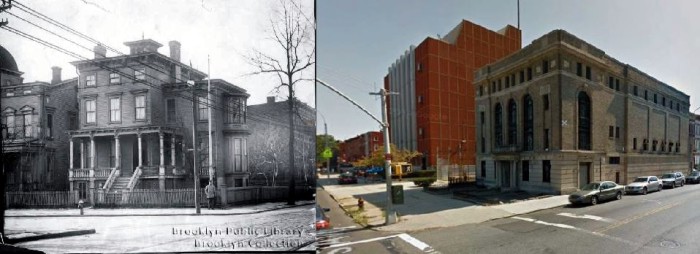
A look at Brooklyn, then and now.
From the Brooklyn Collection at the Brooklyn Public Library comes today’s Past and Present offering. For at least 70 years, the Ibert house stood on the southeast corner of Bushwick and Gates Avenues, at 1054 Bushwick Avenue.
When it was no longer someone’s home, it became a popular gathering hall for organizations and parties. Then it was torn down, replaced by today’s Ridgewood Masonic Temple. And we almost lost that one, too. Here’s the story:
Martin Ibert Sr. was a very successful merchant in Bushwick. His business, called Martin Ibert & Sons, was a flour and feed store operating at 158 Graham Avenue, founded in the 1860s. He sold hay and feed for horses in addition to milled flour for people.
The Ibert family had another branch that was in the brewery business. Frank Ibert ran a very successful brewery, which was also in Bushwick, on Grove Street between Evergreen and Central Avenues. It was called, simply enough, the Frank Ibert Brewery Company.
At some point, one of these men, or perhaps even an earlier Ibert, built this house and gave it its name, the Ibert Mansion. The house was called that in the caption of this photograph taken in 1911.
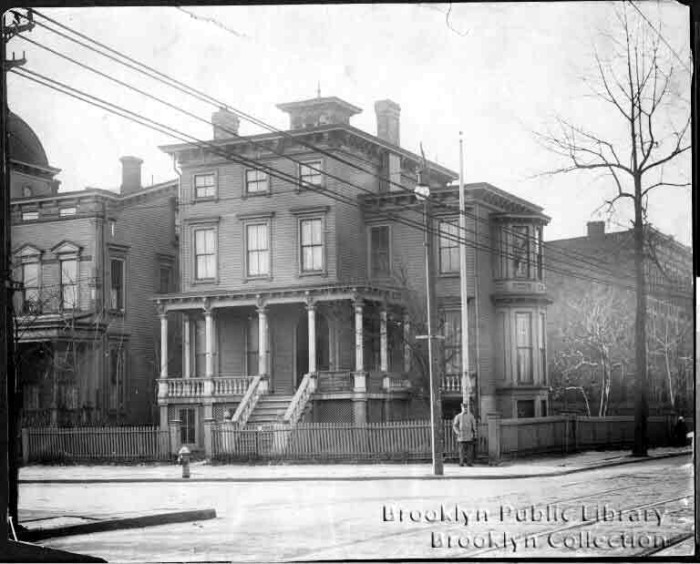
Unfortunately, no record of an Ibert living here turned up in the research.
From the style of the house, it dates from the 1850s or early 1860s. It’s a classic Italianate villa, complete with a cupola, floor to ceiling parlor-floor windows, a large porch and classic Italianate eaves and brackets. Unlike most wood-framed Italianates, it’s not square, but a tall rectangle with a large added wing on the side, complete with another bump-out bay. This 1888 map shows the house and its similar wood-framed neighbors.
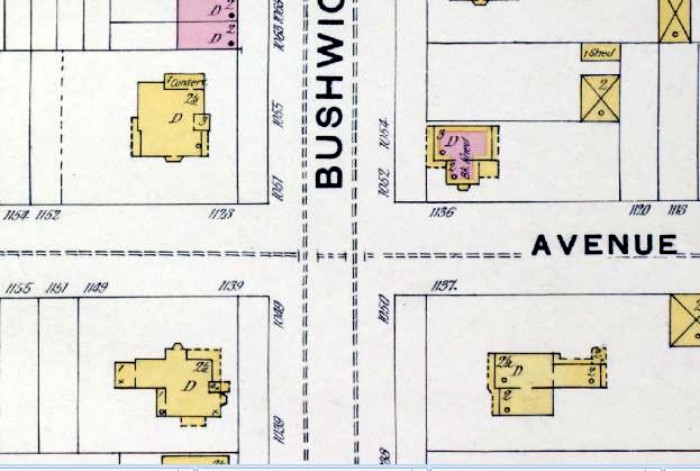
Martin Ibert and his son Martin Jr. were in the news quite a lot in 1878 because of a spectacular robbery of their establishment by three notorious crooks. Their store was robbed in the middle of the night in May of that year; their safe was broken open and money and other objects were stolen.
Part of the story of that robbery and the ensuing investigation and arrests was told in a Walkabout piece called “Betrayed by a Common Hammer.” The tale of the trial of the perpetrators and of their fate is worthy of an update at some point. It was quite the story in its day.
At any rate, at that time, there were no Iberts living in the Bushwick Avenue home; they had moved on. The address of the house gets no mentions in the press until 1894, when the homeowner at the time, named John Parker, was living here with his two adult sons. He was 65 years old and a semi-invalid.
In April of 1894 Parker overheard his doctor telling his sons that he did not have long to live. Parker had been seriously ill for some time, and was failing. He managed to make it into his bathroom, where he took out his revolver and shot himself in the head.
The bullet went into his temple and lodged itself in the base of the brain. He was rushed to the hospital, where he later died. His sons told the Eagle they didn’t even know their father had owned a gun.
Another life-changing event, though a less devastating one, took place here four years later, in 1898. This house was the first home of newlyweds William Anthony Betts and his bride Etta Jean Goodwin. Betts came from a large real estate family, whose members were responsible for much of the development in Bedford, Crown Heights and Stuyvesant Heights, among other neighborhoods.
The couple moved here after their honeymoon in June of ’98. But soon they were separated, and by 1902, they were in court for a divorce.
By 1905, the house had an entirely new function. It was now called the Maretta Mansion, and was an event space. It hosted parties and functions, and served as a meeting place for civic and neighborhood groups, especially Bushwick’s political organizations.
The newspapers now spoke of the house and its grounds being used for fundraisers, with afternoon teas on the lawn, dinner dances and strawberry festivals. Often festooned with bunting, the house played host to political celebrations and rallies as well as birthday parties and ladies’ club events.
The Maretta Mansion was in business from about 1905 until 1912. That December, the paper announced that the building had been sold to a builder and developer, who planned to put an apartment building on the lot. The property went for only $20,000.
Directly across Bushwick Avenue stood the Turn Verein Club, which had been expanded by Theobald Engelhardt in 1905, with new brick extensions added to a frame Italianate villa from the same era.
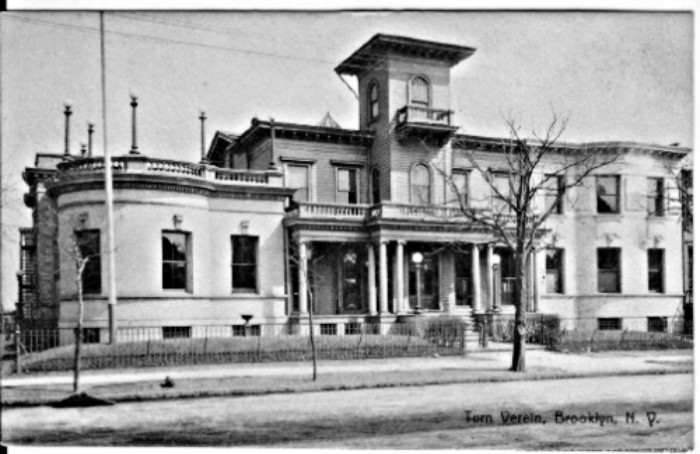
The Turners were a German social and athletic club, very important to the history of this German community. The old villa had been called the Tuttle mansion.
On the other side of Gates Avenue stood two other wood-framed villas. They would both be replaced by large apartment buildings in the 1920s. But instead of becoming the site of an apartment building too, the Ibert house was replaced by the Ridgewood Masonic Temple.
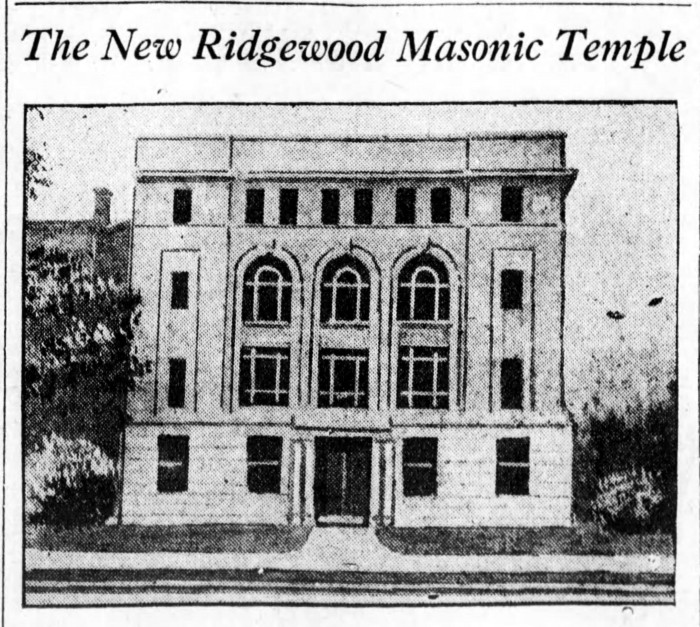
This large structure was designed by the firm of Koch & Wagner in a simplified Beaux Arts style. The lodge opened in October of 1920.
Between the Masons and the Turners, this was a very civic minded and busy corner of Bushwick. Many of the area’s leading citizens belonged to both organizations.
The Turners left Brooklyn in the 1950s or 60s. They’ve gone from having many New York and Brooklyn chapters to one, located in Throgs Neck, in the Bronx. A church now stands on the former club site.
The Masons left in the 1970s, merging with another lodge in Queens. The building was used for photo shoots, parties and as a concert venue for a while. Later it stayed empty and abandoned for years.
It looked as if it might sit empty and crumbling, like many such large civic buildings, which take imagination for adaptive reuse. In 2014, the building was designated an individual landmark, one of the few in Bushwick.
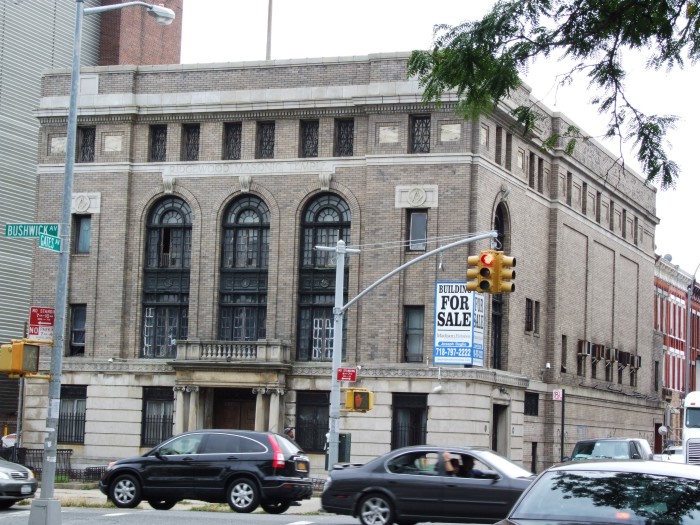
Fortunately, this January, an announcement was made that the Masonic Lodge would become apartments. Brownstoner covered the story here. Although few remember the wood-framed house that once sat here, its history is still part of the greater history of Bushwick. Landmarking guarantees that any new additions to the building that replaced it will not take away from its historic, dignified appearance on the Bushwick streetscape.
Below, the lodge as it appears today. The large structure next door is a Verizon building.
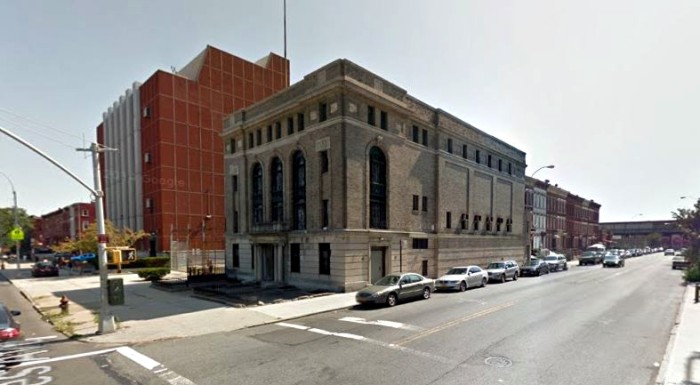





Montrose, Thanks for your great story – a friend forwarded it to me. I’m a Great Grandson of Frank Ibert, the brewer, who lived at 1041 Bushwick Ave. – across the street from the house in your story. I believe his house (which was larger) may have (also?) been referred to as the Ibert Mansion. If you’re interested, I have a pretty good picture of that house. Would be great to see if anyone out there has any information or stories relateing to it. The Brooklyn Eagly Archives have many mentions of my Great Grandfather, that have been fun to read. Apprently he was a very well known guy in his day. Regards, Gene
While an Ibert may not have lived in THIS mansion, it does appear that the family did reside in another stately building that was situated at the corner of Linden St. and Evergreen Ave. This was right next to the brewery that the family owned. While the residence is long gone – it is now occupied by a parking lot for busses – the brewery building remains. In addition to the brewery, the Iberts’ operated a restaurant and – at least for a short time – a small movie theater at this location. The remaining brewery building now hosts a church, which has maintained it rather well.
Terrific story as usual MM. I know Armbruster mentioned this mansion in his book and it was great to actually view it.
At the extreme left of the old photo is a small portion of a domed building that was situated where the Verizon atrocity currently exists. There should be a story about that old structure as well.